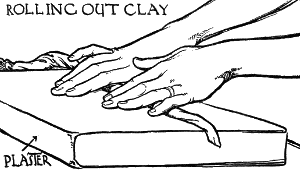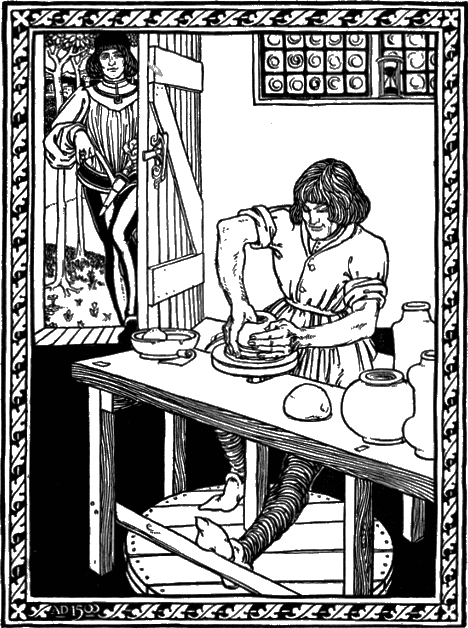The text will conform to changes in window size.

 “He wrought a work upon the wheels, and thevessel that he made of clay was marred in the hands of the Potter: so hemade it again another vessel, as seemed good to the Potter to makeit.”—(Jeremiah.)
“He wrought a work upon the wheels, and thevessel that he made of clay was marred in the hands of the Potter: so hemade it again another vessel, as seemed good to the Potter to makeit.”—(Jeremiah.)POTTERY,
FOR ARTISTS
CRAFTSMEN
& TEACHERS
GEORGE J COX, ARCA.
INSTRUCTOR in POTTERY & MODELLING AT
TEACHERS COLLEGE—COLUMBIA UNIVERSITY
ILLUSTRATED by the AUTHOR
PRINTED IN THE UNITED STATES OF AMERICA
COPYRIGHT, 1914,
By THE MACMILLAN COMPANY
Set up and electrotyped. Published November, 1914.
Norwood Press
J. S. Cushing Co.—Berwick & Smith Co.
Norwood, Mass., U. S. A.
Thou art my Master, and I fail to bring
Before men’s eyes the image of the thing
My heart is filled with.”
EXPLANATION
In such a spacious craft as Pottery it is difficult to steer a fair coursebetween the empirical and the scientific. With that in mind this book setsout to tell in simple terms some of the processes of Potting, practicableto the student and to the more finished craftsman.
It is an intricate task to combine successfully the view-points of theartist and the scientist; but it seems that, without neglecting the manybenefits bestowed by the advance of science, the Potter should stand withthe former. The best in his craft has been produced by men that wereartists rather than chemists. And what has been accomplished by loving,patient craftsmanship may surely be done again only in such ways.
To the artist craftsman, for whom chiefly this book is intended, a littlescientific knowledge is a dangerous thing; for that reason no great stressis laid on formulas and analysis. Unless thoroughly understood they are ahindrance rather than an aid.
Although many schools teach elementary pottery, the expense of equipmentpossibly delays its introduction on a larger scale. For that reason I havepreferred to err on the side of over-exactness of description andprofuseness of illustration.viii
The slight historical review and introductory remarks are to be excused onthe ground that they are intended to help to a study of the best work ofthe best periods, and so to foster a taste for the finest Ceramics. Thisis a vital matter when laying the foundations of a craft so fascinatingand so full of alluring avenues to beckon the student from the true path.
To the scientific critic I would offer a hundred books with a thousanddiff